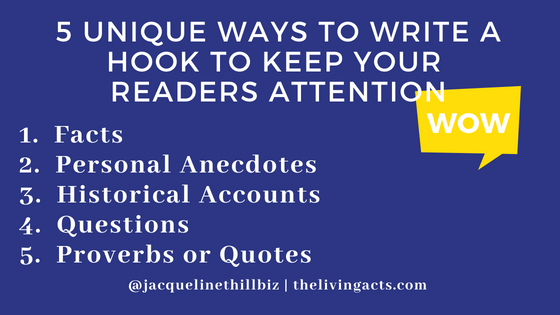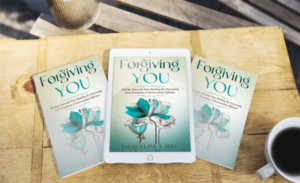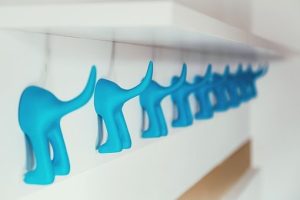What is the Hook?
The hook is used interchangeably for both your headline and the opening sentence of your writing piece.
If you’re writing a blog, essay, or non-fiction book, you will need an opening line that hooks your readers.
The hook, whether as a headline or introduction, gets your readers attention.
There are different ways to write your hook. This piece will focus on how to write a hook for your introduction.
What you’re about to learn you can apply to your writings. I will use business marketing for writing a hook as my examples.
Besides, as writers or aspiring writers, after you write and publish the next stage is marketing. This stage automatically puts you in business ownership.
Here Are 5 Different Ways To Use A Hook
A Hook Uses Facts
As you already know, facts are not opinions, what you think or feel about something.
Writing facts for your hook related to your topic comes from two definite areas: what you know also known as prior knowledge and research.
It’s best to research facts about your topic. Try not include your personal experiences for this area. And, remember a fact is something that is true and you can prove.
Facts for a hook include also includes statistics. When starting your hook with facts, be sure to check for its accuracy. Definitely, use reliable sources cite and link (when applicable) them correctly.
Some of the best sources to use for facts in your hook are Newspapers like Huffington Post, CNN, Entrepreneur, etc. Also, consider relying on encyclopedias and sometimes Wikipedia–people have rights to go in to change information.
So, factual examples to start your hook with the topic business marketing of looks something like this:
Eric T. Wagner begins his article with an emotional statement. Next, he writes a fact about small business failure. Here’s what he writes.
“Breaks my heart.”
“According to Bloomberg, 8 out of 10 entrepreneurs who start businesses fail within the first 18 months. A whopping 80% crash and burn.”
Notice I am linking to the article because this text is for online purposes. If this were for a book, I’d create works cited or bibliography page to be sure to credit Wagner for his statement.
A Hook Can Begin With A Personal Anecdote
A personal anecdote simply means to hook your reader with a portion of your personal story. It needs to relate to your topic.
Your personal story, of course, is drawn from personal experiences. Should you use this area of the hook, be prepared to be transparent.
Being transparent about your personal story is a good way of branding yourself. Your readers want to know who you are and about your start.
I understand for some writers it’s strictly fiction or business. But, for those of you who are willing to share your story, please don’t hesitate.
Your readers will connect with you differently. Plus, you’ll begin to gain their trust.
Take for instance this article by Daphne Mallory. She pulls no punches. Mallory uses an interesting story about how she met her husband to hook the reader.
Mallory starts by writing in first person. She writes, “I met my husband using an online dating service. He was in Alaska and I was in Atlanta. One of the things that convinced me that our relationship had potential was the fact that his parents owned and operated a cattle ranch.”
After writing an incredible headline, “3 Tips for Running a Business With Your Spouse Without Divorcing or Going Broke,” she maintains the reader’s attention by opening with meeting through an “online dating service.”
This is an outstanding hook because some online business owners and others will relate to this experience. At the same time, some do not agree with the online dating world.
 A Hook Can Start With A Historical Account
A Hook Can Start With A Historical Account
Now, you may be thinking, this area of the hook is similar to what we learned about facts.
You’re right. They are very similar and have a stark difference.
This side of the hook relates to history. It’s solely connected to past events and provides evidence of the past.
There will always be some aspect of history you and your readers will connect to and disagree or agree with.
Historical accounts have the power to spark interesting conversations and emotions.
Let’s look at how writer Kathleen Davis uses a historical account for readers. She adds a little more flavor to this hook.
“What a long, strange trip it’s been for marketing. From the first magazine published in 1741, to the first billboards in the late 1800s, the art of getting the public’s attention and turning it into sales has gone through a dramatic evolution over the past few hundred years.”
Notice how she uses a hyperbole in the beginning. A hyperbole is an exaggeration, “What a long, strange trip…” I will not get into the usage of literary devices. But, they will not hurt your introduction or opening.
Like I mentioned earlier, literary devices add flavor and a little more style to your writing.
She goes on to write about the historical account of marketing, Remember once you start publishing your writing, the next part is marketing.
Don’t Hesitate To Hook Readers With A Question
There are different ways to start with a question. And, please remember no question is wrong. Depending on how you ask your question determines your reader’s reaction.
Conversely, we teach thought dot com contends there is a difference between a good and bad question. This site asserts that
Good Questions
- Provokes Thinking
- Naturally causes more questions
- Clarifies Understanding
- Causes Hope
Bad Questions
- Stops Thinking
- Leads to Uncertainty
- Obscures Understanding
- Causes Doubt
In this case, we’ll stick with good, thought-provoking questions. Pay attention to the questions of your readers and or followers.
They ask questions all of the time. Take their questions, evaluate and research them for SEO and buzz purposes. Use the question as your hook. Then, answer the question to help form your paragraph with more details.
You may have noticed that I started this article with the question “What is the hook” and proceeded with an answer and definition.
Hook Your Readers with a Proverb or Quote
A proverb or quote is merely an old wise saying. You see them used a lot in quote graphics and memes. They are your friends and savior. Always keep a proverb in your back pocket.
If you find the right one for your readers, you’ll hook them for your writing. As writers, we know there is a tiny window to hook the reader. And, it has to work through the headline, book title, topic and opening sentence.
Google quotes and keep your eyes open and pen ready for the memes and quote graphics you see floating around on social media.
Again, be sure to cite who said it, wrote it or created it. If it says “anonymous” or “unknown author” still credit it for what it says.
Conclusion
Overall, the best part about writing an introduction is you have many options. Using one of these five ways to hook your readers gives your writing style more variety.
It’s possible to stick with only one that better fits your style and voice. However, if you choose to incorporate each one for different contexts and content you write, either will work.





